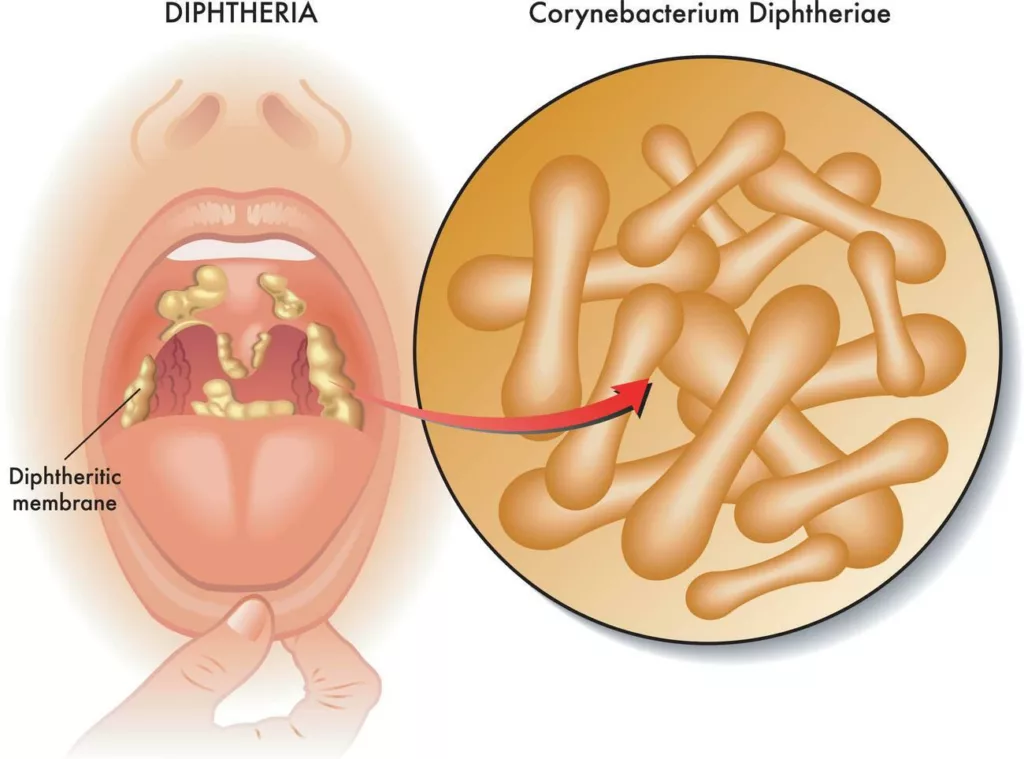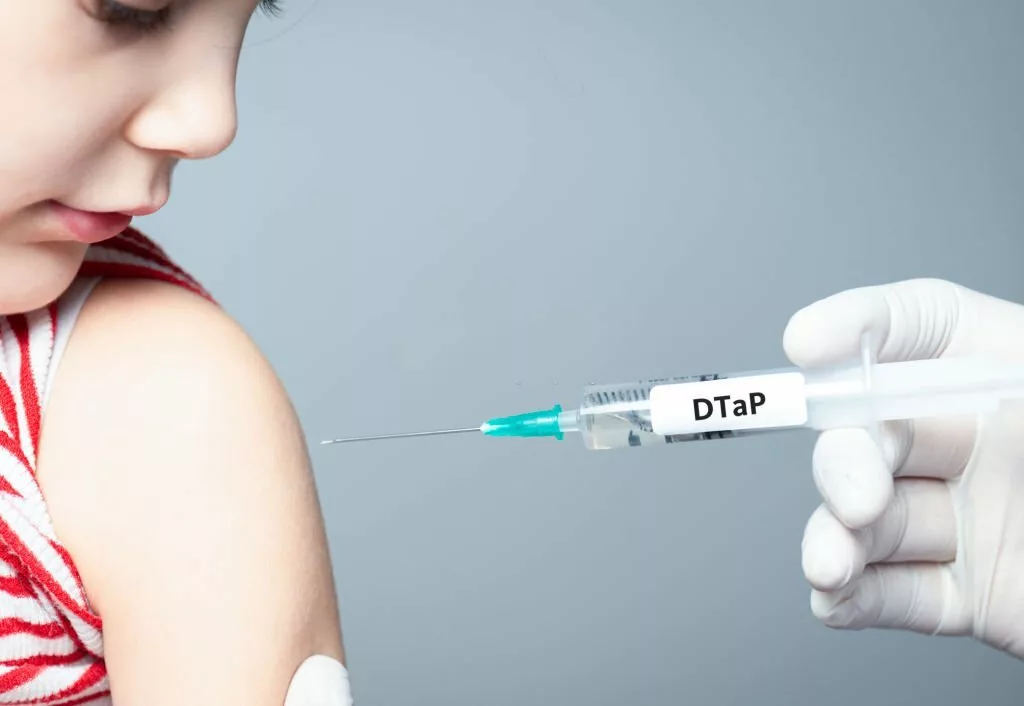Pharyngeal diphtheria, caused by the bacteria Corynebacterium diphtheriae, is a potentially life-threatening illness. It is characterized by the formation of a greyish membrane in the throat, which can obstruct the airways. In addition to airway blockage, the diphtheria toxin can sometimes lead to cardiac and neurological complications. Diphtheria is a vaccine-preventable disease, but multiple doses and booster doses are needed to produce and sustain immunity.1World Health Organization. (n.d.). Diphtheria. Retrieved from https://www.who.int/news-room/fact-sheets/detail/diphtheria#:~:text=Diphtheria%20is%20a%20disease%20caused,to%20produce%20and%20sustain%20immunity.
This condition can cause various symptoms, including fever, sore throat, trouble swallowing, and the development of a grayish-white membrane on the tonsils and pharynx. It mainly affects the mucous membranes of the throat and upper respiratory tract. In severe cases, myocarditis, an inflammation of the heart muscle, and nerve damage can result from diphtheria. Respiratory droplets or close contact with sick people or items can transmit the illness, and it is highly contagious.

Historically, diphtheria was a significant contributor to infant mortality in New Zealand until the 1960s. Nowadays, diphtheria infections are rare in the country and typically occur due to travel-related exposure.2Nicholson, L., Adkins, E., Karyanti, M. R., Ong-Lim, A., Shenoy, B., Huoi, C., & Vargas-Zambrano, J. C. (2022). What is the true burden of diphtheria, tetanus, pertussis, and poliovirus in children aged 3–18 in Asia? A systematic literature review. International Journal of Infectious Diseases.
Where does Diphtheria Occur?
Diphtheria tends to thrive in regions with limited sanitation and high population density. However, individuals who remain unvaccinated or have not completed their vaccination schedules, particularly children, are at a heightened risk. The disease is most prevalent in countries like the Pacific Islands, Papua New Guinea, and Indonesia. Over the past three decades, several nations have experienced significant outbreaks. The bacteria can reside in an infected person’s skin, throat, mouth, and nose.
The highest incidence of the disease is observed in sub-Saharan Africa, India, and Southeast Asia. Given the high efficacy of the vaccine in preventing the disease, healthcare professionals recommend vaccination for individuals of all ages, especially those traveling to regions where diphtheria is more prevalent.3Shafiee, F., Aucoin, M. G., & Jahanian-Najafabadi, A. (2019). Targeted diphtheria toxin-based therapy: a review article. Frontiers in microbiology, 10, 2340.
Diphtheria Toxin
Corynebacterium diphtheriae bacteria produce a potent toxin called diphtheria toxin. When these bacteria infect a human host, they grow and release this toxin, which can significantly damage human tissue, especially the respiratory system. Once released, the toxin enters the bloodstream, posing a threat to vital organs like the heart and kidneys. Beyond causing severe health complications, this toxin can even lead to paralysis.4Castro, E. (2021). Epidemiological Characteristics in Patients with Diphtheria in the Autonomous Service University Hospital of Maracaibo. Science, 10(4), 113-119.
How Do People Get Diphtheria?
Diphtheria is caused by Corynebacterium diphtheriae and is highly contagious. It spreads through respiratory droplets when an infected person coughs or sneezes, as well as through contact with secretions from the nose, throat, or infected skin. Additionally, the bacteria can spread through direct contact with open skin wounds or sores. Asymptomatic carriers can also transmit the infection without showing symptoms.
The disease is particularly prone to spread in crowded or unhygienic environments. Good hygiene practices, such as frequent hand washing and covering the mouth and nose when sneezing or coughing, are crucial in reducing transmission. Vaccination remains the most effective method to prevent diphtheria.5Berbers, G., van Gageldonk, P., Kassteele, J. V. D., Wiedermann, U., Desombere, I., Dalby, T., … & He, Q. (2021). Circulation of pertussis and poor protection against diphtheria among middle-aged adults in 18 European countries. Nature Communications, 12(1), 2871.
What Are the Signs & Symptoms of Pharyngeal Diphtheria?
Pharyngeal diphtheria typically presents 2 to 5 days after infection with initial symptoms of a sore throat and low-grade fever. Over time, the following symptoms may develop:
- Sore throat
- Difficulty swallowing
- Enlarged lymph nodes in the neck (bull neck)
- Mild fever
- Fatigue and weakness
- Difficulty breathing
- Bluish complexion (in severe cases due to oxygen deprivation)
- Thick grey or white coating on the tonsils and the back of the throat, which may obstruct the airways
In severe cases, inflammation and swelling in the throat can cause significant airway obstruction, making it difficult to breathe or swallow. If left untreated, the diphtheria toxin can spread throughout the body, causing severe complications such as myocarditis (heart damage), nerve damage (neuropathy), respiratory muscle paralysis, and death. Asymptomatic carriers can also transmit the bacteria without showing symptoms, making the disease harder to control.
If you or someone you know exhibits these symptoms—especially if there has been recent contact with a diphtheria patient or if vaccination history is incomplete—seek immediate medical attention. Early diagnosis and treatment with antitoxin and antibiotics are crucial to prevent life-threatening complications.6Arguni, E., Karyanti, M. R., Satari, H. I., & Hadinegoro, S. R. (2021). Diphtheria outbreak in Jakarta and Tangerang, Indonesia: Epidemiological and clinical predictor factors for death. PLoS One, 16(2), e0246301.
How do Doctors Diagnose Diphtheria?
Doctors diagnose diphtheria based on a combination of clinical examination, medical history, and laboratory tests. During the initial evaluation, the doctor will look for characteristic signs and symptoms, such as a thick grey coating on the tonsils or throat, enlarged lymph nodes in the neck (bull neck), and breathing difficulties.
To confirm the diagnosis, the doctor will take a sample from the affected area, typically using a throat swab or, in the case of cutaneous diphtheria, from skin lesions. This sample is sent to a laboratory for bacterial culture and toxin testing to detect the presence of Corynebacterium diphtheriae and confirm whether the bacteria are toxin-producing.7Rosana Y, Prilandari LI, Ajisman R, Hartono TS, Yasmon A. Detection of toxin-producing Corynebacterium diphtheriae from throat swabs of diphtheria patients using duplex real-time PCR. Iran J Microbiol. 2020 Dec;12(6):508-515. doi: 10.18502/ijm.v12i6.5024. PMID: 33613904; PMCID: PMC7884264.
In some cases, additional tests, such as blood tests, may be conducted to monitor overall health, immune system response, or complications caused by the infection. Since diphtheria can lead to severe complications, it is crucial to seek immediate medical attention if you suspect exposure or notice symptoms. Early diagnosis and prompt treatment with antitoxin and antibiotics are essential to prevent life-threatening outcomes.
How do We Prevent it?
Diphtheria, tetanus, and pertussis (DTaP) vaccination can prevent pharyngeal (throat) diphtheria. In the United States, children receive this vaccination regularly as part of their immunization schedule. People who are at a higher risk of contracting the illness, such as those who travel to countries where the disease is more prevalent, may also receive a booster dose of the vaccine. Moreover, good hygiene habits like routine hand washing and covering the mouth and nose while sneezing or coughing might help stop the spread of diphtheria. The National Immunization Schedule administers the diphtheria vaccine at 6 weeks, 3 months, 5 months, and 4 years of age. Moreover, a booster shot is given at ages 11, 45, and 65.8Pikul, K. V., Syzova, L. M., Il’chenko, V. I., & Zvyagolska, I. M. (2021). Diphtheria: current public health challenge in Ukraine and worldwide (literature review).

Treatment for Diphtheria
Diphtheria is a severe medical condition necessitating immediate treatment. Doctors typically employ antitoxin to counteract the diphtheria toxin and administer antibiotics to eliminate the bacteria. In some cases, mechanical respiratory assistance, such as a respirator, may be necessary for patients with respiratory distress. In severe cases, hospitalization is essential to closely monitor the patient’s respiration and heart rate and provide supportive care like intravenous fluids and oxygen.
Additionally, individuals exposed to someone with diphtheria may be prescribed antibiotics as a preventive measure. Seeking prompt treatment is crucial to prevent complications and reduce the risk of fatality.
Close contacts of the patient should also receive antibiotics and undergo throat cultures. Continuous monitoring for potential signs of infection is essential. Those who haven’t been vaccinated should receive the vaccine, while individuals who missed doses should complete the entire vaccination schedule. Individuals who received a vaccination over five years ago can benefit from a booster shot.
Precautionary Measures
The precautions against diphtheria are:
Vaccination:
Immunization is the most effective method of preventing diphtheria. The diphtheria-tetanus-pertussis (DTaP) vaccine should be given to kids.
Maintaining good hygiene
It can help stop the transmission of diphtheria. Frequent hand washing and covering the mouth and nose when coughing or sneezing are two such practices.
Avoidance
Refrain from being near somebody who has a disease until they have finished their treatment.
Isolation
Patients should be kept in a secluded room until they are no longer contagious.
Antibiotics
Doctors may give antibiotics to close contacts of a patients to stop the bacterium’s spread.
To wrap it up, Diphtheria is a highly contagious bacterial infection that can lead to severe respiratory problems if left untreated. Early recognition of the symptoms, proper diagnosis, and timely administration of antibiotics and antitoxins are crucial to prevent serious complications and reduce the risk of transmission. Vaccination is the best way to prevent this infection, and it is recommended for all children as part of routine immunization. If you suspect you or someone you know may have pharyngeal diphtheria, seek medical attention immediately to receive appropriate treatment and help prevent further spread of the disease.
Refrences
- 1World Health Organization. (n.d.). Diphtheria. Retrieved from https://www.who.int/news-room/fact-sheets/detail/diphtheria#:~:text=Diphtheria%20is%20a%20disease%20caused,to%20produce%20and%20sustain%20immunity.
- 2Nicholson, L., Adkins, E., Karyanti, M. R., Ong-Lim, A., Shenoy, B., Huoi, C., & Vargas-Zambrano, J. C. (2022). What is the true burden of diphtheria, tetanus, pertussis, and poliovirus in children aged 3–18 in Asia? A systematic literature review. International Journal of Infectious Diseases.
- 3Shafiee, F., Aucoin, M. G., & Jahanian-Najafabadi, A. (2019). Targeted diphtheria toxin-based therapy: a review article. Frontiers in microbiology, 10, 2340.
- 4Castro, E. (2021). Epidemiological Characteristics in Patients with Diphtheria in the Autonomous Service University Hospital of Maracaibo. Science, 10(4), 113-119.
- 5Berbers, G., van Gageldonk, P., Kassteele, J. V. D., Wiedermann, U., Desombere, I., Dalby, T., … & He, Q. (2021). Circulation of pertussis and poor protection against diphtheria among middle-aged adults in 18 European countries. Nature Communications, 12(1), 2871.
- 6Arguni, E., Karyanti, M. R., Satari, H. I., & Hadinegoro, S. R. (2021). Diphtheria outbreak in Jakarta and Tangerang, Indonesia: Epidemiological and clinical predictor factors for death. PLoS One, 16(2), e0246301.
- 7Rosana Y, Prilandari LI, Ajisman R, Hartono TS, Yasmon A. Detection of toxin-producing Corynebacterium diphtheriae from throat swabs of diphtheria patients using duplex real-time PCR. Iran J Microbiol. 2020 Dec;12(6):508-515. doi: 10.18502/ijm.v12i6.5024. PMID: 33613904; PMCID: PMC7884264.
- 8Pikul, K. V., Syzova, L. M., Il’chenko, V. I., & Zvyagolska, I. M. (2021). Diphtheria: current public health challenge in Ukraine and worldwide (literature review).

